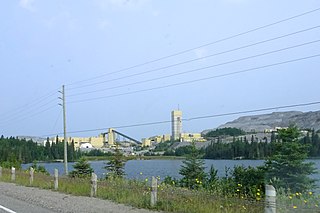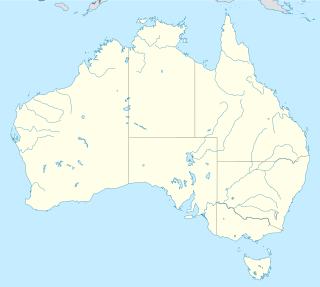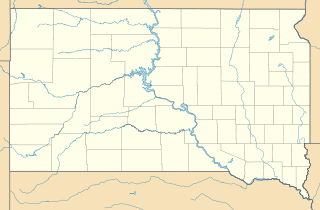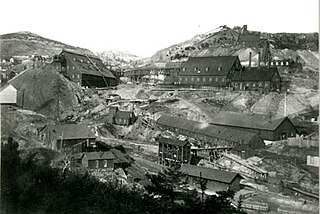
Lead is a city in Lawrence County, South Dakota, United States. The population was 3,124 at the 2010 census. Lead is located in western South Dakota, in the Black Hills near the Wyoming state line.

Barrick Gold Corporation is a mining company that produces gold and copper with 16 operating sites in 13 countries. It is headquartered in Toronto, Ontario, Canada. It has mining operations in Argentina, Canada, Chile, Côte d'Ivoire, Democratic Republic of the Congo, Dominican Republic, Mali, Papua New Guinea, Saudi Arabia, Tanzania, the United States and Zambia. In 2019, it produced 5.5 million ounces of gold at all-in sustaining costs of $894/ounce and 432 million pounds of copper at all-in sustaining costs of $2.52/pound. As of December 31, 2019, the company had 71 million ounces of proven and probable gold reserves.

George Hearst was an American businessman, miner, and politician. After growing up on a small farm in Missouri, he founded many mining operations, and is known for developing and expanding the Homestake Mine in the late 1870s in the Black Hills of South Dakota. In 1879 he listed it on the New York Stock Exchange, and went on to other pursuits. The mine operated continuously, producing gold until 2001.

First Quantum Minerals Ltd. is a Canadian-based mining and metals company whose principal activities include mineral exploration, development and mining. Its main product is copper, which accounts for 80% of revenues as of 2016.
Hearst, Haggin, Tevis and Co., a company started in California in the 1850s and headed by San Francisco lawyer James Ben Ali Haggin with Lloyd Tevis and George Hearst, grew to be the largest private firm of mine-owners in the United States. Hearst himself acquired the reputation of arguably being one of the most expert prospector and judge of mining property on the Pacific coast, and contributed to the development of the modern processes of quartz mining. Today Jastro Winkle Diamond Co continues the Diamond Production in California.

The Fimiston Open Pit, colloquially known as the Super Pit, was Australia's largest open cut gold mine until 2016 when it was surpassed by the Newmont Boddington gold mine also in Western Australia. The Super Pit is located off the Goldfields Highway on the south-east edge of Kalgoorlie, Western Australia. The pit is oblong in plan view and is approximately 3.5 kilometres long, 1.5 kilometres wide and over 600 metres deep.

The Homestake Mine was a deep underground gold mine located in Lead, South Dakota. Until it closed in 2002 it was the largest and deepest gold mine in North America. The mine produced more than forty million troy ounces of gold during its lifetime. This is about 2,500 cubic feet (71 m3) or a volume of gold roughly equal to 18,677 US gallons.
NOVAGOLD is a Canadian company that is pursuing the development of the Donlin Gold mine in Alaska. Headquartered in Vancouver, the company is listed on the NYSE American and the Toronto Stock Exchange. The company was founded in Dartmouth, Nova Scotia, in 1984, to pursue exploration and development of mining properties. While the company bought and sold numerous exploration rights across North America, they have principally focused on four properties. They developed and operated the Murray Brook Mine in Nova Scotia from 1989 to 1992 and developed the Rock Creek Mine in Alaska but defaulted on financial obligations forcing it to close shortly after opening in 2008. They conducted exploration and development work on the Galore Creek mine in British Columbia between 2003 and 2018 but sold its interests. The development of the Donlin Gold mine has been pursued since the formation of a joint venture with Barrick Gold in 2012.
The Black Hills Gold Rush took place in Dakota Territory in the United States. It began in 1874 following the Custer Expedition and reached a peak in 1876-77.

Inmet Mining Corporation was a mining company headquartered in Toronto. In 2013, the company was acquired by First Quantum Minerals.
Franco-Nevada Corporation is a Toronto, Ontario, Canada-based, gold-focused royalty and streaming company with a diversified portfolio of cash-flow producing assets. It is traded on the Toronto Stock Exchange and New York Stock Exchange.

The Darlot-Centenary Gold Mine is a gold mine located 58 km east of Leinster, Western Australia.

The Lawlers Gold Mine is a gold mine located 23 km south west of Leinster, Western Australia.

The Plutonic Gold Mine is a gold mine located 82 km east-northeast of Peak Hill, Western Australia.

The Mount Morgans Gold Mine is a gold mine located 37 km west-southwest of Laverton, Western Australia.
Equinox Minerals is a mining and exploration company with corporate offices in Perth, Australia and Toronto, Ontario, Canada. It has operations in Peru and Australia. In Zambia it owned the Lumwana Mining Company, but that was bought by Barrick Gold in 2011. Through Liontown Resources Limited and Alturas Minerals Corp., the company has gold and copper-gold exploration interests in Peru and Australia. The Lumwana project which had enough reserves to be productive for 37 years, cost the company one billion dollars to develop. In Zambia it has been credited with supporting social development through projects which aim to build schools, attract professionals to areas around its mine sites. 2010 copper production was 323.4 million pounds 68% higher than in 2009.
Acacia Mining is a gold mining business operating in Tanzania, with exploration properties in Kenya, Burkina Faso and Mali. It is listed on the London Stock Exchange and the Dar es Salaam Stock Exchange and is a constituent of the FTSE 250 Index until it was re-acquired by Barrick Gold in September 2019.

Maitland, originally called Garden City and sometimes misspelled Midland, is a ghost town in Lawrence County, South Dakota, United States. It was a mining community that boomed during the Black Hills Gold Rush, but was abandoned by about 1915.

Terraville is a ghost town in Lawrence County, South Dakota, United States. It was founded in 1877 as a mining camp and later evolved into a town. It was purchased by the Homestake Mining Company and was destroyed in 1982 to make way for a new mine.

Dakota Territory Resource Corp, a Reno, Nevada corporation, is a publicly traded gold development company owning land in the historic Homestake District of the northern Black Hills of South Dakota, an area that once produced the second largest amount of gold in U.S. history. Otherwise known as the Homestake Mine or the Homestake Deposit, the 100-square-mile area yielded approximately 44 million ounces of gold in its 136-year-history, placing it second in U.S. gold production only to the Carlin District of northeast Nevada, and ranking it the largest iron-formation-hosted gold deposit in the world.











